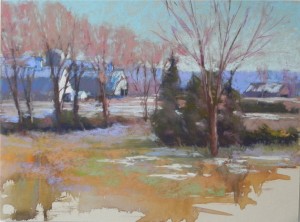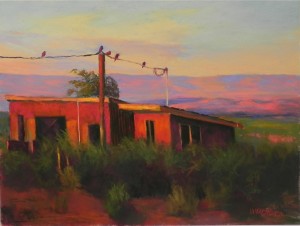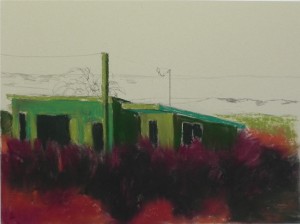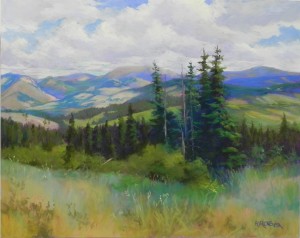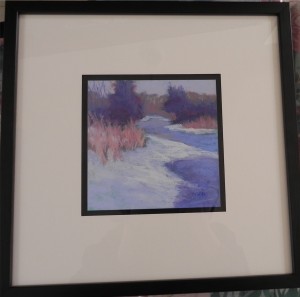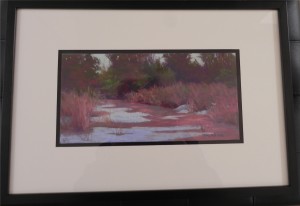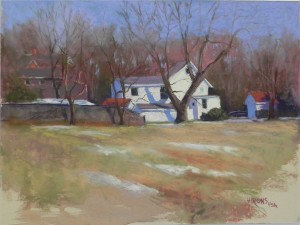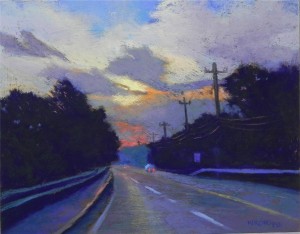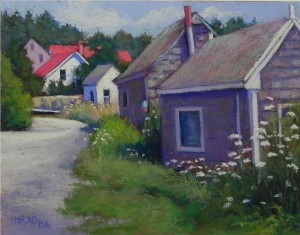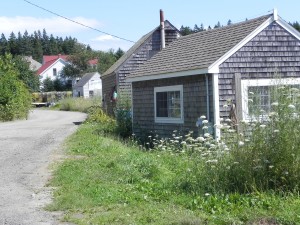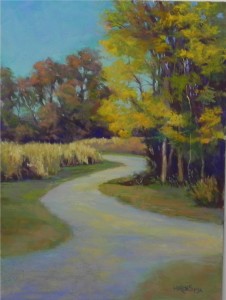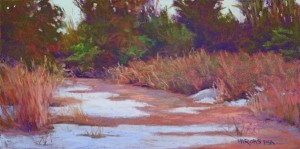I’m back from a week in Massachusetts. Visiting my mother and giving a workshop on the Cape, along with three days of painting with friends were the highlights. The bombing and a fall that left me with an injured back were the negatives. This is the second demo I did for the workshop (Pastel Painters Society of Cape Cod). It’s an example of a center of interest painting. The left barn was supposed to be the center of interest but as I lowered the evergreens into the foreground and then added a tree in front, this area started to take prominence. The original photo was completely on one plane with a large, dull field taking up most of the picture! So they all agreed that I improved on the composition. They also made me stop! I’m not sure this is really done yet and I had to leave the picture there, but I thought I’d share it with you. This is one of the most lightly painted pastels I’ve ever done! It’s the same surface and place as the white house in Poolesville in an earlier post. The photo for this one was so uninteresting, however, that it really needed something! I did a watercolor wash and then applied pastels very lightly on over and redrew with graphite in places.
Category Archives: Uncategorized
The Last Song
I think I’m on a western kick. I found this photo from Washington State that I tried to paint several years ago. It was a disaster! I went into the reds too soon and I didn’t like it at all. So I decided to try it again, sneaking up on the reds! I did a lot of drawing and didn’t want to lose my lines. So I decided to do a partial underpainting using hard pastel but no wash. I used complementary color, putting greens under the red and dark reds under the greens. Then, because there were lots of little light pieces of paper showing through, I mooshed it all with my hands! I then sprayed it with workable fixative. I used direct application of soft pastel for the sky and background mountains, then added various reds and oranges to the building, letting little pieces of green show through. The foreground is all Girault greens. This was a much more successful painting than the first one. It’s my second use of the UART 500, using a very different technique. But I like the surface very much. Here is the underpainting. I find that it’s a lot of fun looking at a photo and thinking about the possibilities of how to make it work and, since writing the book, I now have a much better sense of what these possibilities are!
On the Road to Jackson
I seem to be all over the map these days–from Maryland, Maine, and Massachusetts–to Wyoming! This is a case of having exhausted my recent shots and being in a real painting mood. This photo is one I’ve had in the photo book I bring to classes for student use for several years. Having just received my set of 50 Girault greens (and not having much green outside right now), I decided to try them out. I worked on a new, white Pastelbord. The clouds and sky were done with Blue Earth pastels. There are a lot of different tones of grayed blues in them, but they look a little peaked. Using the new Giraults on the hard Pastelbord was a little daunting. They felt hard and I did a certain amount of scribbling with them. But in the end, I really liked the soft effect and the lack of cakey buildup. One of the things I’ve always liked about the photo are the blues in the background and the combination of light blue green and yellow grasses in the foreground. Using several blue violets and the greens from my new set was perfect for achieving a wide variety of greens. I began this painting with charcoal wash, followed by a hard pastel/alcohol underpainting of reds, oranges, and lavender.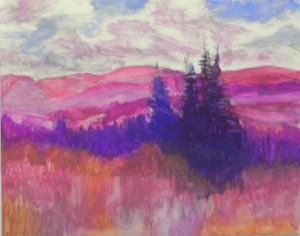
Framed studies
I promised I’d send an image or two of how I frame my paintings by floating the mat around them. Here are two that I picked up this morning. The black outline around the painting is a black mat that the board has been glued to (by my framer). The spacer was applied to the black mat and the white mat was cut to allow about 3/8″ of black showing. This can be done with two white mats to give a double matted look. Sorry I couldn’t seem to film these straight. The dark spot in the middle of Path to the Sea is me hovering over the picture! Not perfect, but hopefully you get the idea! I’m happy with the look of these. My larger pictures will be framed primarily with warm silver plein air frames.
A Center of Interest Painting
I’m working on a new surface. I ordered ProArt Panels with UART 500 grit surface some weeks ago in 11 x 14 and 12 x 16 sizes and this is my first chance to use one. I’m preparing for two workshops in Massachusetts coming up in mid-April where I will discuss the difference between what I see as “center of interest” and a “big shape” picture. I’m going to be using the UART for the first and thought I’d better try it out. To date, I’ve used the 280 (which is too rough) and the 400 (which I like a lot). The 500 is finer and more like Wallis. With the exception of the sky and the “whites,” I used nothing but Giraults on this picture and they felt just right. The surface is quite fine and the pastel goes on very easily, quickly filling the paper, so the harder Giraults are great for it. I did a watercolor underpainting and was pleased with the results. The color of the paper is such that you could work directly on it, but I wanted to use water color to see how it would work at the bottom of the painting, where I wanted to leave it unfinished. Because the paper is mounted and cut to the exact size, the edges can be difficult to cover as there is a very slight lip. But they won’t show under a frame. This is very different from the bolder, big shape pictures that I’ve been doing for years now. But it was a pleasure to do and, who knows, maybe my style (like my eyesight) is changing!
Daybreak, Route 6
Here is another painting done on a reclaimed pastelbord. The values in this painting were a real challenge (as was the filming!). The “black” areas of trees are a combination of dark violet and reddish brown, with a slightly lighter green on top. Getting the values of the sky and the light and dark clouds was challenging because, while the darker clouds look “dark” compared to their surroundings, they were lighter than the road and sidewalk. Darkening the lighter areas of cloud helped put it in balance. I should have used a black and white photo for help, but was lazy. The textured board had too much texture on the top and I had a hard time getting the clouds to look right. I almost gave up on it a number of times and was wishing I was working on UART or Wallis! But brushed-on surface worked really nicely in the road and made it very easy to quickly lay in the trees. Hand-made surfaces can be a lot of fun to work on, but they don’t take the same amount of pastel that quality papers do, and you have to use really soft pastels once there are multiple layers. I tried using Unison in the sky and had to switch to Schmincke. Still, I had fun doing this picture, which is yet another from Mattapoisett. Of course, this could be anywhere.
Roof Tops
My latest painting was begun on Monday during our latest snow event. I’ve been looking at this photo from Maine for some time. I really liked the way the planes of the buildings lead the eye back into the area where there are sunlit houses and red roofs. However, the dull, gray, weather beaten shingled buildings scared me–and that large expanse of roof as well! I decided to use a re-used Pastelbord on which I had applied two coats of reddish-toned AS Colourfix liquid primer. This had the advantage of creating subtle lines, that show in the roof (maybe not in this image though). Using the 11 x 14, which is squarer than the photo, allowed me to shorten the foreground building. I then made the window smaller and when painting, used many colors in the siding and roof. I learned years ago that there is nothing more boring than a large expanse of roof that is all the same! So I used warm and cool colors of the same value (pinks, oranges, greens, and aqua) to lay in color and provide a more interesting surface. On a completely different note, I’m very honored to be included in the latest issue of the Pastelagram, the magazine of the Pastel Society of America. I’m featured as someone who paints buildings in the landscape, so I’m glad that I’ve returned to buildings for a bit! Thanks to editor Robert Carsten for including me.
When the Color Photo is Needed
It’s snowing like crazy here! I’ve cancelled my Monday class and am looking out at winter wonderland–not really what I want the week before Easter! I’ve just spent time finishing off last week’s painting. When I worked on it last Monday I only had a black and white photo. I began with a charcoal wash and liked the way the trees developed. I then did an underpainting with hard pastel using some really wild color–bright yellow green in the sky! I worked with the soft pastels fairly intuitively, knowing this is a scene from autumn on the Maryland Eastern shore. But there were some problems–the main one being that the sky and the leaves were the same value, as were the road and the neighboring grass. So it was very hard to determine where each should be! I did my best, but this morning I worked with the color photo. I really liked the shape of the sky holes in the trees and I was losing a lot of that with the B & W photo. In the photo, the background trees are all green and the foreground foliage is orange. I didn’t change that, trying to be faithful to my intuitive color. But I did carve out more sky pieces and worked on the color of the road.
An Experiment
Last weekend I decided to experiment with washed off Pastelbord. One of the things I like about the surface is that it can be reused. However, I find that once washed off, it’s too smooth and has lost some of its tooth. My solution has normally been to add one or two coats of Art Spectrum liquid primer, either toned or clear. But this really changes the surface to something completely different. So I decided to try spraying the surface with Krylon workable fixative. I gave it a good spray outside and let it dry, then started playing. I found that the surface was quite “hard” and that hard pastels wouldn’t do much on it. So I decided to experiment in another way: do a painting completely with my four boxes of Blue Earth pastels (blue, cerulean, orange, and yellow). The buttery consisency of these pastels worked quite nicely on the hard surface and I was able to apply a number of layers. (I did resort to Giraults for the small tree branches.) I have MANY used boards sitting around ready to be reused! I’ll probably put gel on some and try the spray again on others. It’s definitely not a perfect solution. Another issue regarding Pastelbord: I have noticed that the surface of the gray 12 x 12 boards seems to have less density than the white 16 x 20s. Has anyone else noticed this difference? (This painting will probably end up in the sink as well! It’s based on a remarkable photo of a huge rising moon in Easton, MD that I took years ago.)
Path to the Sea
This is the small painting that I mentioned last week in the post about pastel bliss. As I said, it is a quiet picture, but I managed to add a lot of color that wasn’t there. I intended the center of interest to be where the path leads into the distance. The clump of grasses on the left grabs the eye and hopefully leads it into the background, as does the strong diagonal of grasses on the right. I used blue violet in the snow in the foreground (barely visible on my monitor) and warmer colors in the snow in the middle. I think this makes a big difference in the actual painting. Took it and others for my October show in Bethesda to my framer’s yesterday. Decided to frame this by attaching to a black mat and floating an off-white mat around it with 3/8th” of black showing. Will use a small, flat black frame. It creates quite a distinctive look and the floating mat allows the entire surface to show. It works very nicely for boards like this.

